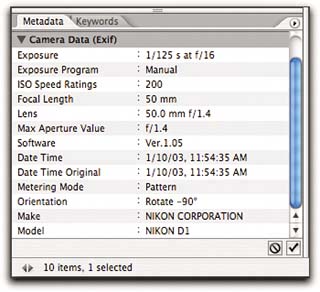Chapter 8. Mastering Metadata: The Smarter Image
| Metadata, which literally means "data about data," isn't a new idea by any means. Library catalogs are good examples of long-established metadata systemsthe data is what lies between the covers of the book, while the metadata includes information about the bookwho wrote it, who published it, when both parties did so, what it's about, and where in the library it's located, for starters. Metadata isn't new to photography either. Photojournalists have long relied on the metadata properties specified by the IPTC (International Press Telecommunications Council) to make sure that their images get delivered correctly with the appropriate photo credit. But two factors are bringing metadata to the front burner for all photographers, not just photojournalists.
Digital captures are already rich in metadata straight out of the camera, but one of the problems that has plagued early adopters has been a plethora of proprietary and often incompatible methods of writing and storing metadata. This is an ongoing battle. The EXIF (Exchangeable Image File Format) "standard," for example, is sufficiently vague that the exchangeability pretty much applies exclusively to JPEGs. Camera vendors are allowed a great deal of freedom ("too much freedom" is a phrase I rarely use, but it applies here) to use private proprietary fields in EXIF to encode important information. For example, it seems to bring no conceivable benefit to Nikon shooters if the image White Balance settings are recorded by the camera in such a way that only Nikon software can read them directly, but that's how some current Nikon cameras work. This is not to single out Nikonthere's more than enough blame to go around, and almost every vendor who produces cameras that shoot raw does something similar with one or another piece of metadata. Moreover, the EXIF standard contains quite a few redundancies: ExposureTime and ShutterSpeedValue tags both record the same information but use different encodings, as do the FNumber and ApertureValue tags. Some vendors use one, others use the other, entirely at their own whimin short, the EXIF standard is a textbook example of what happens when a group of vendors whose sole aim in life is to compete with one another get together to make a standard. Bridge's metadata panel tries to protect you from the EXIF mayhem by always reporting values consistentlyfor example, it always reports an Exposure value as shutter speed and aperture setting. If you need to see the original EXIF data, or if you're simply wondering why some other image browser doesn't report things in exactly the same way, you can see the original untranslated EXIF data by choosing File Info from either Bridge's or Photoshop's File menu, then clicking Advanced and opening the EXIF properties listsee Figure 8-1. Figure 8-1. Metadata mayhemFile Info's EXIF properties list in the Advanced panel shows the raw EXIF metadata.
Bridge's Metadata panel translates the raw EXIF metadata into a more friendly and more useful format.
The intent here isn't to beat up on the camera vendors (well, not much), but rather to demonstrate just how badly we need a standard framework for handling metadata as well as pixel data. That's why XMP is so important to the future not only of photography, but of all the enterprises that consume photography: XMP is to metadata what DNG is to raw pixel dataa great idea waiting to happen. Until such time as XMP (or some other standard that's really standardized) comes into play, we're all pioneers, and recognizable as such by the collection of arrows protruding from our backs! |
EAN: N/A
Pages: 112

